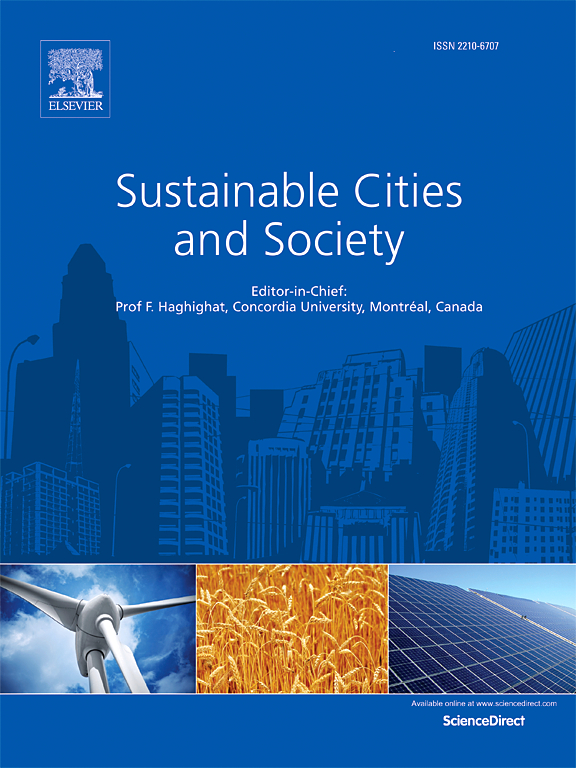结合局地气候带方案的WRF模式对上海市热平衡特征的探讨
IF 10.5
1区 工程技术
Q1 CONSTRUCTION & BUILDING TECHNOLOGY
引用次数: 0
摘要
明确城市空间大气热平衡机制的特征,对于制定有效的缓解城市热岛效应的对策至关重要。本文以上海市为研究对象,利用WRF模式和局地气候带(LCZ)方案,模拟了上海市不同区域的城市气候,分析了感热平衡分量平流、湍流扩散和人为热释放的特征。主要发现如下:1)不同区域平流分量特征表明,海风和湖风对上海气温的降低均有显著作用,且海风作用更大;②内陆地区高空风速垂直梯度增大幅度大于沿海地区,导致内陆地区城市空间大气净感湍流扩散分量显著低于沿海地区;3)上海地区的人类感热释放(SAH)分布总体上与lcz相关,开放高层和重工业类型区域的SAH明显高于其他区域。在此基础上,结合上海不同区域城市空间大气热平衡特征,确定了不同区域热岛缓解对策,有助于改善城市热环境条件。本文章由计算机程序翻译,如有差异,请以英文原文为准。
Exploring the heat balance characteristics in Shanghai by using the WRF model coupled with Local Climate Zone scheme
Clarifying the characteristics of the heat balance mechanism of urban space atmosphere is crucial for developing effective countermeasures to mitigate urban heat island (UHI) effect. This study focused on Shanghai, using the Weather Research and Forecasting (WRF) model coupled with the local climate zone (LCZ) scheme to simulate the urban climate and analyze the characteristics of the sensible heat balance components—advection, turbulent diffusion, and anthropogenic heat release—within different regions of Shanghai. The key findings are: 1) the characteristics of advection components in different regions indicate that sea breezes and lake breezes both play significant roles in reducing the air temperature in Shanghai, with sea breezes being more effective; 2) the vertical gradient of wind velocity in the upper air of inland regions increases more than that of coastal regions, leading to a significantly lower net sensible turbulent diffusion component of urban space atmosphere in inland regions compared to coastal regions; 3) the distribution of sensible anthropogenic heat release (SAH) in Shanghai is generally correlated with LCZs, with the SAH is significantly higher in open high-rise and heavy industry types areas compared to other areas. Furthermore, this study determined the UHI mitigation countermeasures for different areas based on the heat balance characteristics of urban space atmosphere in different regions of Shanghai, contributing to the improvement of the urban thermal environment conditions.
求助全文
通过发布文献求助,成功后即可免费获取论文全文。
去求助
来源期刊

Sustainable Cities and Society
Social Sciences-Geography, Planning and Development
CiteScore
22.00
自引率
13.70%
发文量
810
审稿时长
27 days
期刊介绍:
Sustainable Cities and Society (SCS) is an international journal that focuses on fundamental and applied research to promote environmentally sustainable and socially resilient cities. The journal welcomes cross-cutting, multi-disciplinary research in various areas, including:
1. Smart cities and resilient environments;
2. Alternative/clean energy sources, energy distribution, distributed energy generation, and energy demand reduction/management;
3. Monitoring and improving air quality in built environment and cities (e.g., healthy built environment and air quality management);
4. Energy efficient, low/zero carbon, and green buildings/communities;
5. Climate change mitigation and adaptation in urban environments;
6. Green infrastructure and BMPs;
7. Environmental Footprint accounting and management;
8. Urban agriculture and forestry;
9. ICT, smart grid and intelligent infrastructure;
10. Urban design/planning, regulations, legislation, certification, economics, and policy;
11. Social aspects, impacts and resiliency of cities;
12. Behavior monitoring, analysis and change within urban communities;
13. Health monitoring and improvement;
14. Nexus issues related to sustainable cities and societies;
15. Smart city governance;
16. Decision Support Systems for trade-off and uncertainty analysis for improved management of cities and society;
17. Big data, machine learning, and artificial intelligence applications and case studies;
18. Critical infrastructure protection, including security, privacy, forensics, and reliability issues of cyber-physical systems.
19. Water footprint reduction and urban water distribution, harvesting, treatment, reuse and management;
20. Waste reduction and recycling;
21. Wastewater collection, treatment and recycling;
22. Smart, clean and healthy transportation systems and infrastructure;
 求助内容:
求助内容: 应助结果提醒方式:
应助结果提醒方式:


